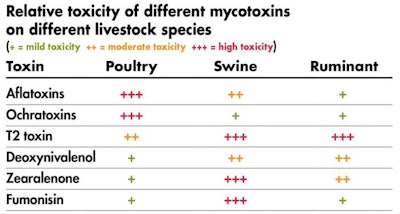
From WATTAgNet:
In 2009, the European Commission opened a new functional group under Regulation (EC) 1831/2003 for feed additives acting on the reduction of the contamination of feed by mycotoxins. This was the first amendment to the Feed Additive Regulation, put in place in 2003, and was an important step forward in the integrated fight against mycotoxin contamination of feed.
Mycotoxins in feed can have negative, and potentially deadly, effects on poultry and livestock.
Aspergillus spp. mycotoxin aflatoxin (AFB1) and ochratoxins are highly toxic for poultry. Pigs, however, are at greatest risk from mycotoxins produced by Fusarium spp. fungal diseases, such as deoxynivalenol (DON), zearalenone (ZON), fumonisin (FUM) and T2 toxin.
In poultry, AFB1 is a carcinogenic compound that is known to affect gene regulation and metabolism at the cellular level, the symptoms of which include liver damage, development of fatty liver, immune suppression and reduced growth rates. In contrast, OTA is associated with renal dysfunction and kidney damage, and is reported to affect weight gain, feed intakes and immune function. Both can cause increased mortality where levels of exposure are high.
Each mycotoxin poses a range of different threats to the pig, with pulmonary oedema characteristic of acute poisoning with FUM, while the trichothecenes are toxic to gut epithelial cells and known to cause intestinal lesions. Since gut health and integrity are critical to efficient nutrient digestion and absorption, such exposure leads to poorer feed conversion efficiency, lower feed intakes and reduced liveweight gain. Along with FUM, the trichothecenes also impair immune function, increasing susceptibility to disease.
EC makes group for mycotoxin regulation
According to the new regulatory status, three modes of action are recognized: substances that can suppress or reduce the absorption of mycotoxins, promote their excretion, or those that modify their mode of action.

















